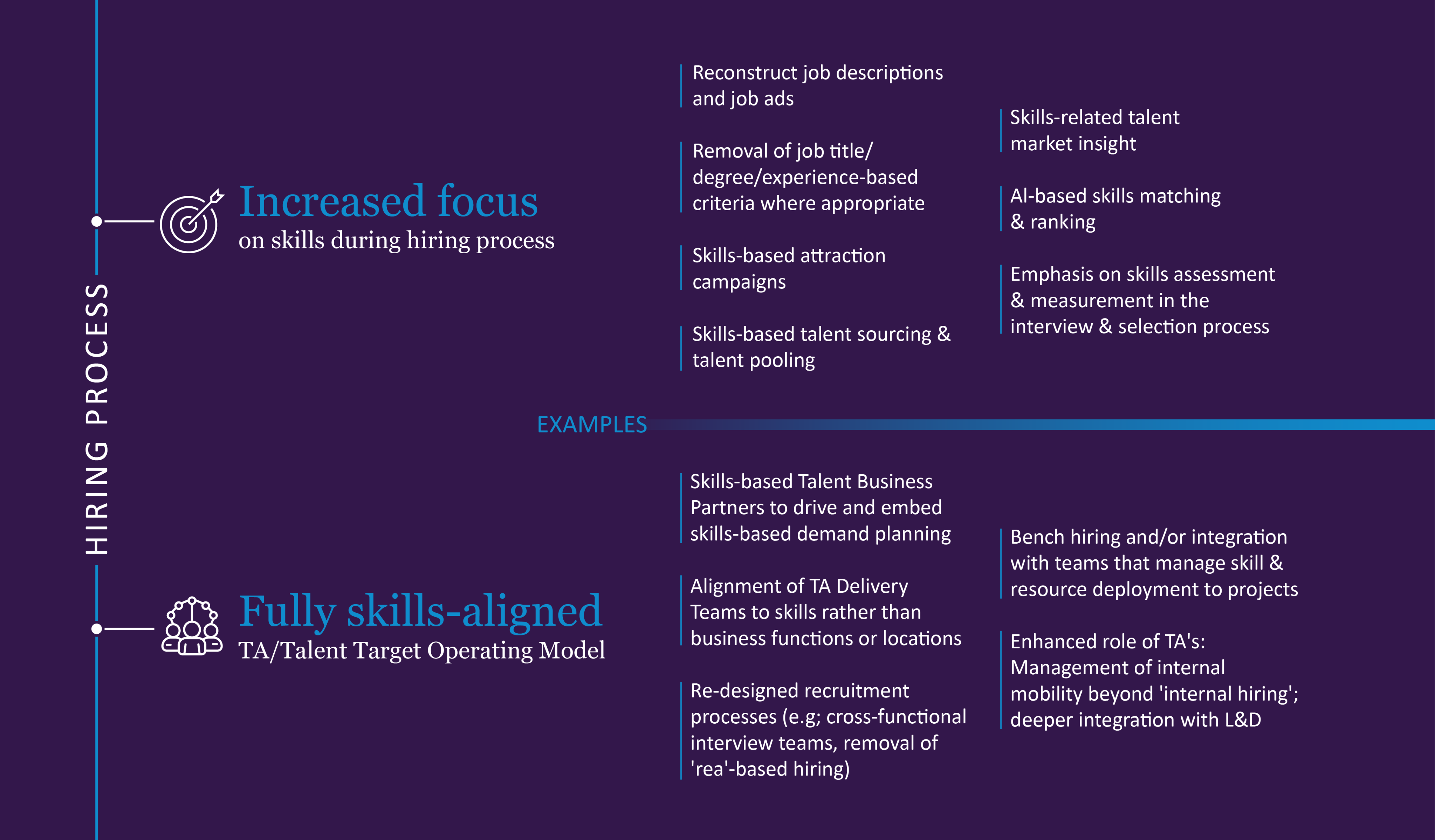The road to a skills-based future
3 practical steps to build a skills based talent strategy

Contributors:
Author:
Kirstin Schulz
Head of Consulting, Talent Acquisition and Advisory - EMEA, AMS
Author:
Nikki Hall
Chief People Officer, AMS
Editor:
Nicola Matson
Head of Technology and Analytics Advisory - EMEA, AMS
Section 1
What we’ve learned so far
Skills-based approach in talent acquisition and management
A few years into the rise of skills-based approaches in talent acquisition (TA) and talent management (TM), it’s time to reflect: What have we learned? How has the conversation evolved? And most importantly, what tangible results have we seen?
A skills-based approach refers to an increased focus on skills during the hiring process to attract a diverse pool of candidates that can contribute their expertise to valuable work. In our work with many organizations, we have encountered the full range of views: From organizations still undecided on the value of skills-based approaches, to those experimenting in specific areas, and others fully committing to large-scale transformations across the entire talent lifecycle. We’ve also noticed that “skills-based” has become an umbrella term, encompassing different strategies and methods of implementation. Each approach aims to drive impactful change and revolutionize how talent is managed to and achieve organizational outcomes.
In this guide, we’ll share insights from our own skills journey, as well as from our work with other organizations, illustrating how we’ve learned that moving to a skills-based organization is a journey with many twists and turns—a journey that requires thoughtful planning with an ability to pivot and an open mind to learn and adjust along the way.


There is no one way of doing it
In its most transformational form, becoming a skills-based organization means shifting away from “job roles” with fixed remits and responsibilities embedded within a defined organizational structure. Instead, the focus should be placed on identifying, developing and deploying employee skills to deliver work across functional or role boundaries.1,2
For others, a skills-based model emphasizes integrating skills throughout the entire talent lifecycle, providing clearer visibility into the skills required for jobs, assignments or projects. It further emphasizes putting skills at the centre of all HR and talent practices, from hiring through to performance management, reward, mobility, promotion and L&D interventions, while leaving the concept of roles, jobs and organizational hierarchies broadly untouched.
This is not surprising, given that organizations differ in their appetite for change and in how they are impacted by macroeconomic talent trends.
Regardless of your approach, the desired and expected benefits are mostly wide-ranging and transformative, such as the following:
- Improved ability to identify and re-train employee segments whose skills will become obsolete
- Improved talent outcomes like retention of high performers
- Improved diversity outcomes
- Improved resource and skill utilization
- Improved organizational agility, effectiveness and ability to ward off the impact of well-documented skill shortages.
What can skills-based hiring look like for organizations?
From a TA perspective, we have seen skills-based approaches applied mostly through challenging a long-held focus on attributes such as education, degree requirements, job title and experience. There has been a lot of valuable discussion about how a shift away from these traditional job requirements and candidate search criteria can help widen the talent pool and have positive impacts on diversity metrics.3,4 For instance, we helped one organization, implement skills-based TA as part of their attraction campaign to foster an inclusive culture.
On the other hand, some organizations put the focus mostly on identifying transferable and adjacent skills during the sourcing process. The pandemic has taught us some interesting lessons here, as flight attendants were quickly retrained to assist medical staff 5, and companies like Unilever reported the redeployment of 8,000 employees and 30,000 employee hours.6 Many of our sourcing teams can showcase their own successes. For example, we have sourced outside-industry talent at scale for one of our Financial Services clients, discovering candidates who wouldn’t have been considered before. Another notable success was hiring talent from entirely different backgrounds, such as hiring watchmakers for hard-to-fill service technician roles for medical devices; though the “object” might be different, the underlying skill set of manual dexterity and the ability to work with fine and delicate machinery is transferable.

In our experiences, the extent of which organizations embed skills-based approaches into their hiring processes and principles can vary significantly: From an increased focus on skills during the hiring process, through to redesigning the operating model (see visual). While many organizations have made progress with the first category of interventions, the second remains ambitious for many.
And a final observation – when approaching skills-based practices through the lens of TA, the perspective of candidates should never be an afterthought: When you “sell” the prospect joining a world of opportunities where you can apply and grow your skills, but instead ending up in a standard role with a defined remit, and no obvious path to ‘what next’ - who is accountable for ensuring that the skills-proposition delivers on its promise?
AMS Case Study: Our own internal approach to skills-based.
In addition to partnering with organizations, we have been on our very own skills journey since early 2024. Why? Because we looked at a range of factors and realized we needed to do things differently, for example:
- Market volatility: As an outsourcing and advisory business, we need to rapidly upscale, downsize and shift resources towards demand and projects
- Client needs: With a demand for highly skilled TA specialists, we must deliver services from and to diverse locations and be able to re-skill them on industries, role types or client technologies
- Evolving TA trends: As technology and AI evolve, we must be able to rapidly upskill our team on emerging trends, technologies and ways of working
- Career development: We have the ambition to offer unrivaled career opportunities to our nearly 10,000 employees globally and be an employer of choice for TA talent globally
Keeping focused on the business outcomes you are trying to drive throughout the move to a skills-powered talent journey is critical. It's easy to lose sight of this when you are in the midst of implementation, especially when evaluating the rapidly changing technology options available, including AI, as well as developing your skills taxonomy. We benefited from a strong PMO and expert consultants to help us evaluate the options available to us.
- Nikki Hall, Chief People Officer, AMS

Section 2:
Three practical steps to build a skills based strategy
1. Choose a starting point
The first question is where do we start? Should we take strategic leaps or focus on specific areas like hiring, talent management or talent marketplace? Implementing skills-based approaches varies by organization. For some organizations, we have started with skills-based hiring initiatives, while for others, we began with a talent marketplace or a skills-driven LMS. Ultimately, the best approach depends on selecting one or several use cases that address a clear business challenge. Once the use case is identified, a solid business case for change is essential: Whether seeking commitment for a small pilot or embarking on a complex transformation with a technology implementation, project sponsors will need to secure buy-in for resources, time and investment. For large-scale initiatives with ambitious goals, clearly defined workstreams, subject matter experts (SMEs), a robust PMO and strong governance will be crucial. Additionally, a well-thought-out change management and adoption strategy is vital: Although integrating skills throughout the entire talent and HR lifecycle feels logical and intuitive, change impacts can feel overwhelming once you get into the operational detail.
Finally, you will need the right technology partner. Whether they are already within your existing tech stack or one you need to procure, it's important to allocate enough time for a thorough vendor selection process to ensure you choose technology that will evolve and grow with you as you expand. Be clear on your use cases and how they shape your requirements, ask the right questions, and understand the vendors’ product roadmap to ensure long-term alignment. In particular, the foundational skills ontologies and capabilities of AI in identifying relevant skills and skills connections have accelerated in recent years and should now be able to do much of the heavy lifting. However, it's important to remember that having skills mapped in a technology is only half the battle—getting business leaders and people managers on board is just as critical. This is because considering talent with transferable or adjacent skills often sparks a conversation about trainability, upskilling, time-to-competency and the necessary resource investments, which your HR teams need to be prepared for.

2. Plan and run a skills program
As outlined above, there are a lot of ways to approach a skills program and many methods of running it. In this section, we’ll review some common principles to consider.
- Understand the broader business context: It may sound obvious, but it is worth spending time fully understanding the wider business context in which you are running the program. How will the program contribute to your organizational business strategy, how will you manage the risk of funding being challenged? Are there any other key change initiatives that could inadvertently create challenges if you send conflicting messages or underestimate the impact of change?
- Establish strong governance: This project will likely compete with other HR and non-HR projects, so getting early sight of adjacent projects that might affect or impact your skills transformation is useful—as is fully understanding any other changes that may hit the workforce at the same time.
- Focus beyond technology: Don’t treat this as just a “technology implementation.” While technology is the enabler of change, there are many other crucial elements to consider for success. Understanding how much of the process is system-enabled vs. what will happen offline, and identifying which HR policies, ways of working and embedded behaviors will need to change are all key factors in resource planning and change management. Taking a holistic view will ensure the solution is properly integrated into your organization's broader objectives.
- Map out the transformation program: Tackling a large transformation can feel overwhelming, so it's crucial to clearly outline each element of the program, including launch timelines and target audiences (enterprise vs. pilot groups). Creating small, sprint-like testbeds for new processes or functionalities will help you avoid tunnel vision and help clarify questions that will directly impact user experience and adoption, such as:
- How will AI improve the accuracy of an individual’s skills profile? - What are the potential side effects of self, manager or peer skill ratings?
- How will you manage the process for assigning and accepting skills-based gig opportunities?
- Does the UI feel intuitive and engaging?
- What language will resonate most with users?
- Create effective workstreams: Whether the transformation is large or small, creating the right workstreams with the right collaboration approach is important:
- Technology and systems: Extending or implementing a skills-based approach to hiring or talent management will likely include some kind of technology enabler, either through extending what you already have in place or implementing new ones.
- Process and experience: SMEs accountable for understanding the depth and breadth of talent process changes must understand the effects on different user groups.
- Change, communications and adoption: Probably the most critical of all workstreams—SMEs leading on this will need to be well-versed in understanding change impacts and getting to the hearts and minds of all impacted users. Anticipating concerns, signposting change, embedding the initiatives in a compelling narrative and creating a strategy to maximize adoption is critical.
- Project management and governance: Successfully coordinating all activities, managing and mitigating risks and ensuring you have the right governance in place is the accountability of the PMO. Depending on the size of your program, you may be unlikely to map out the entire journey at the start. Agility is important, especially if you must work in new product releases with changes to assumed features and functionalities that you thought you bought, and other little curveballs that might occur.
- Always tie decisions back to your core objectives and the KPIs you aim to improve. Whether it’s reducing external hiring costs, identifying workforce segments that will require upskilling or boosting employee sentiment, regularly reviewing your success criteria will help you stay focused and avoid getting distracted by issues that don’t significantly impact your goals.

3. Identify the enablers and obstacles you need to prepare for
- Your approach to skills – The way you approach skills can significantly impact the success of your project and has the potential to stall the project early on if you get tied up in knots. While some vendors may suggest you "just get started" and let their AI handle the rest, it's important to critically evaluate how their approach affects key areas, such as skill accuracy and user experience. Here are a few factors to consider:
- Broad vs. specific skills: Skills can range from general, like "Leadership" or "Communication," to highly specific, like "Python programming for machine learning."
- Customization of skills: The flexibility to add, remove or adjust skills, as well as link skills to others and define skill levels can differ across platforms.
- Linking skills to roles: Some systems allow skills to be tied directly to roles, while others focus on linking them to individuals. It’s also important to check if skills can be pushed to individuals in key roles.
- Skill ratings and validation: How skills are rated, validated and used for decisions (such as promotions, hiring decisions or simply deciding which next online course you should take) should be clearly mapped out to ensure accuracy and fairness.
- Minimum viable product (MVP) – Defining and agreeing on an MVP will help you determine if you are comfortable going live with a piece of functionality. Aiming for perfection from Day 1 is only going to delay the launch—incremental improvements can be tackled in the next stage.
- Managing change and adoption through pilot groups and feedback – In a global, matrixed organization, different regions and cultural perspectives often influence views on which functionalities are most critical and how best to drive system adoption. Aligning user groups and senior leadership expectations can be challenging. However, establishing a clearly signposted “release roadmap,” testing your assumptions via pilot groups and sounding boards to gather feedback and socializing your plans can significantly improve alignment and adoption.

In conclusion...
The idea of a skills-based organization is very attractive and makes intuitive sense. Whether you are an ardent supporter fully on the journey or experimenting in small pockets, expectations are high. If executed well, it has the potential to truly re-frame how we think about “talent” and how we tackle the talent puzzles many organizations are facing. However, the impact of a skills-based model depends on how it's implemented—and some may argue, "Haven't we always hired, promoted and developed talent based on skills?"
Regardless of where you are, our recommendation is to always take it back to the fundamentals: The rationale for why you are pursuing this initiative, what “skills-based” means to your organization and how that translates into clear and compelling use cases is the foundation for success. Maintaining an end-to-end talent lifecycle view in mind helps align the big picture and systemic perspective with the smaller tweaks you are making in parts of the talent process, even if you’re only experimenting in select areas.
Ultimately, success isn't just measured by ROI but also by the real stories that emerge—hiring top talent that would otherwise not have made it to the shortlist, fostering new connections and collaborations through learning and mentoring platforms or colleagues flourishing in ‘non-traditional’ career trajectories. When done right, this approach can unlock significant value and transform how your organization manages talent.

Sources used:
1 Deloitte (2022) The skills-based organization: A new operating model for work and the workforce
2 The Skills-Powered Organization: The Journey to the Next-Generation Enterprise (Ravin Jesuthasan and Tanuj Kapilashrami, 2024)
3 McKinsey (2022): Taking a skills-based approach to building the future workforce
4 LinkedIn (2023): Skills-First: Reimagining the Labor Market and Breaking Down Barriers
5 Grounded Flight Attendants Are Being Redeployed To Hospitals In Coronavirus Battle
6 Deloitte (2021) , Global Human Capital Trends: The social enterprise disrupted: Leading the shift from thrive to survive


